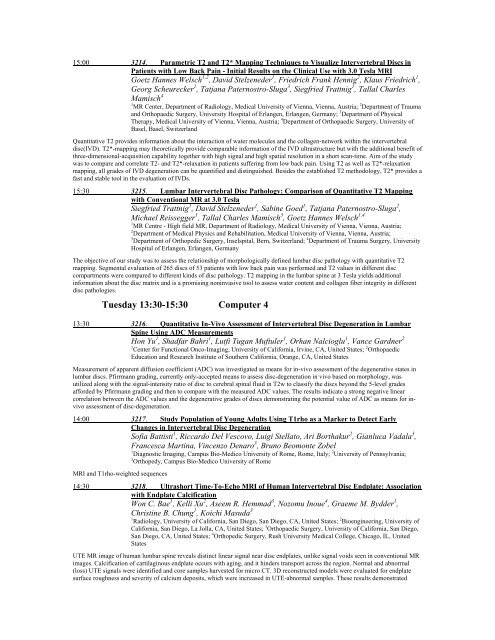ELECTRONIC POSTER - ismrm
ELECTRONIC POSTER - ismrm
ELECTRONIC POSTER - ismrm
You also want an ePaper? Increase the reach of your titles
YUMPU automatically turns print PDFs into web optimized ePapers that Google loves.
15:00 3214. Parametric T2 and T2* Mapping Techniques to Visualize Intervertebral Discs in<br />
Patients with Low Back Pain - Initial Results on the Clinical Use with 3.0 Tesla MRI<br />
Goetz Hannes Welsch 1,2 , David Stelzeneder 1 , Friedrich Frank Hennig 2 , Klaus Friedrich 1 ,<br />
Georg Scheurecker 1 , Tatjana Paternostro-Sluga 3 , Siegfried Trattnig 1 , Tallal Charles<br />
Mamisch 4<br />
1 MR Center, Department of Radiology, Medical University of Vienna, Vienna, Austria; 2 Department of Trauma<br />
and Orthopaedic Surgery, University Hospital of Erlangen, Erlangen, Germany; 3 Department of Physical<br />
Therapy, Medical University of Vienna, Vienna, Austria; 4 Department of Orthopaedic Surgery, University of<br />
Basel, Basel, Switzerland<br />
Quantitative T2 provides information about the interaction of water molecules and the collagen-network within the intervertebral<br />
disc(IVD). T2*-mapping may theoretically provide comparable information of the IVD ultrastructure but with the additional benefit of<br />
three-dimensional-acquisition capability together with high signal and high spatial resolution in a short scan-time. Aim of the study<br />
was to compare and correlate T2- and T2*-relaxation in patients suffering from low back pain. Using T2 as well as T2*-relaxation<br />
mapping, all grades of IVD degeneration can be quantified and distinguished. Besides the established T2 methodology, T2* provides a<br />
fast and stable tool in the evaluation of IVDs.<br />
15:30 3215. Lumbar Intervertebral Disc Pathology: Comparison of Quantitative T2 Mapping<br />
with Conventional MR at 3.0 Tesla<br />
Siegfried Trattnig 1 , David Stelzeneder 1 , Sabine Goed 1 , Tatjana Paternostro-Sluga 2 ,<br />
Michael Reissegger 1 , Tallal Charles Mamisch 3 , Goetz Hannes Welsch 1,4<br />
1 MR Centre - High field MR, Department of Radiology, Medical University of Vienna, Vienna, Austria;<br />
2 Department of Medical Physics and Rehabilitation, Medical University of Vienna, Vienna, Austria;<br />
3 Department of Orthopedic Surgery, Inselspital, Bern, Switzerland; 4 Department of Trauma Surgery, University<br />
Hospital of Erlangen, Erlangen, Germany<br />
The objective of our study was to assess the relationship of morphologically defined lumbar disc pathology with quantitative T2<br />
mapping. Segmental evaluation of 265 discs of 53 patients with low back pain was performed and T2 values in different disc<br />
compartments were compared to different kinds of disc pathology. T2 mapping in the lumbar spine at 3 Tesla yields additional<br />
information about the disc matrix and is a promising noninvasive tool to assess water content and collagen fiber integrity in different<br />
disc pathologies.<br />
Tuesday 13:30-15:30 Computer 4<br />
13:30 3216. Quantitative In-Vivo Assessment of Intervertebral Disc Degeneration in Lumbar<br />
Spine Using ADC Measurements<br />
Hon Yu 1 , Shadfar Bahri 1 , Lutfi Tugan Muftuler 1 , Orhan Nalcioglu 1 , Vance Gardner 2<br />
1 Center for Functional Onco-Imaging, University of California, Irvine, CA, United States; 2 Orthopaedic<br />
Education and Research Institute of Southern California, Orange, CA, United States<br />
Measurement of apparent diffusion coefficient (ADC) was investigated as means for in-vivo assessment of the degenerative states in<br />
lumbar discs. Pfirrmann grading, currently only-accepted means to assess disc-degeneration in vivo based on morphology, was<br />
utilized along with the signal-intensity ratio of disc to cerebral spinal fluid in T2w to classify the discs beyond the 5-level grades<br />
afforded by Pfirrmann grading and then to compare with the measured ADC values. The results indicate a strong negative linear<br />
correlation between the ADC values and the degenerative grades of discs demonstrating the potential value of ADC as means for invivo<br />
assessment of disc-degeneration.<br />
14:00 3217. Study Population of Young Adults Using T1rho as a Marker to Detect Early<br />
Changes in Intervertebral Disc Degeneration<br />
Sofia Battisti 1 , Riccardo Del Vescovo, Luigi Stellato, Ari Borthakur 2 , Gianluca Vadala 3 ,<br />
Francesca Martina, Vincenzo Denaro 3 , Bruno Beomonte Zobel<br />
1 Diagnostic Imaging, Campus Bio-Medico University of Rome, Rome, Italy; 2 University of Pennsylvania;<br />
3 Orthopedy, Campus Bio-Medico University of Rome<br />
MRI and T1rho-weighted sequences<br />
14:30 3218. Ultrashort Time-To-Echo MRI of Human Intervertebral Disc Endplate: Association<br />
with Endplate Calcification<br />
Won C. Bae 1 , Kelli Xu 2 , Aseem R. Hemmad 3 , Nozomu Inoue 4 , Graeme M. Bydder 1 ,<br />
Christine B. Chung 1 , Koichi Masuda 3<br />
1 Radiology, University of California, San Diego, San Diego, CA, United States; 2 Bioengineering, University of<br />
California, San Diego, La Jolla, CA, United States; 3 Orthopaedic Surgery, University of California, San Diego,<br />
San Diego, CA, United States; 4 Orthopedic Surgery, Rush University Medical College, Chicago, IL, United<br />
States<br />
UTE MR image of human lumbar spine reveals distinct linear signal near disc endplates, unlike signal voids seen in conventional MR<br />
images. Calcification of cartilaginous endplate occurs with aging, and it hinders transport across the region. Normal and abnormal<br />
(loss) UTE signals were identified and core samples harvested for micro CT. 3D reconstructed models were evaluated for endplate<br />
surface roughness and severity of calcium deposits, which were increased in UTE-abnormal samples. These results demonstrated
















